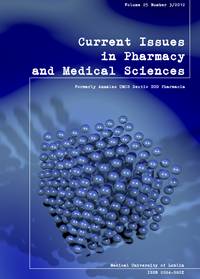Qualitative and quantitative analysis of diosgenin in pure substance by TLC-densitometry
DOI:
https://doi.org/10.12923/j.2084-980X/25.3/a.20Słowa kluczowe:
diosgenin, TLC-densitometry, thin-layer chromatographyAbstrakt
A simple and sensitive TLC-densitometric method for qualitative and quantitative analysis of diosgenin in pure sample was elaborated. Satisfactory results of the densitometric analysis of examined compound was obtained using chloroform-acetone in volume composition 40:10 (v/v) as a mobile phase and by means of the chromatographic plates precoated with silica gel 60F254 and silica gel 60. Visualization of the diosgenin spots was achieved by dipping the plates into 10% ethanol solution of phosphomolybdic acid and 10% ethanol solution of sulfuric acid respectively. The limit of detection (LOD) and the limit of quantification (LOQ) of diosgenin investigated under different chromatographic conditions was determined. The results obtained in this work indicate that, the elaborated method is suitable for densitometric analysis of diosgenin but only in pure sample.
Bibliografia
1. Amir M. et al.: Development and validation of HPTLC method for the estimation of diosgenin in In Vitro culture and rhizome of Dioscorea deltoidea. Acta Chromatogr., 24 (1), 111, 2012.
2. Dołowy M, Niestrój A: Densitometric determination of ursodeoxycholic acid in pharmaceutical formulations in form of tablets and capsules. J. Liq. Chromatogr. & Relat. Technol., 33 (1), 109, 2010.
3. Li J et al.: Determination of diosgenin content in medicinal plants with enzyme-linked immunosorbent assay. Planta Med., 76 (16), 1915, 2010.
4. Ming-Jie et al.: Diosgenin induce cell cycle arrest and apoptosis in human leukemia K562 cells with the disruption of Ca2+ homeostasis. Cancer Chemother. Pharmacol., 55, 79, 2005.
5. Oleszek, WA: Chromatographic determination of plant saponins. J. Chromatogr. A., 967 (1), 147, 2002.
6. Pyka A, Dołowy M, Gurak D: Separation of selected bile acids by TLC. V. Influence of temperature on the separation. J. Liq. Chromatogr. & Rel. Technol., 28 (4), 631, 2005.
7. Pyka A, Dołowy M: Separation of selected bile acids by TLC. I. J. Liq. Chromatogr. & Rel. Technol., 26 (7), 1095, 2003.
8. Pyka A, Dołowy M: Separation of selected bile acids by TLC. III. Separation on various stationary phases. J. Liq. Chromatogr. & Rel. Technol., 27 (13), 2613, 2004.
9. Pyka A, Dołowy M: Separation of selected bile acids by TLC. VI. Separation on cyano - and diol-modified silica layers. J. Liq. Chromatogr. & Rel. Technol., 28 (9), 1383, 2005.
10. Sobolewska D et al.: Densitometric analysis of diosgenin in methanolic extracts of Allium ursinum collected at different times during plant development. J. Planar. Chromatogr., 22 (4), 305, 2009.
11. Stefanowicz-Hajduk J, Ochocka JR: Steroidal saponins – occurrence, characteristic and application in therapeutics. Post. Fitoter., 1, 36, 2006.
12. Trivedi PD et al.: A validated quantitative thin-layer chromatographic method for estimation of diosgenin in various plant samples, extract, and market formulation. JOAC Int., 90 (2), 358, 2007.
13. Wang, L et al.: Simultaneous analysis of diosgenin and sarsasapogenin in Asparagus officinalis byproduct by thin-layer chromatography. Phytochem. Anal., 22 (1), 14, 2011.
Opublikowane
Numer
Dział
Licencja
Prawa autorskie (c) 2012 Autorzy

Praca jest udostępniana na licencji Creative Commons Attribution-NonCommercial-NoDerivatives 3.0 Unported License.


